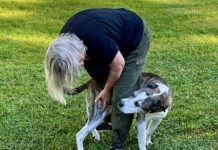Have you ever visited a friend’s or relative’s house and, upon walking in the door, detected the unmistakable aroma of dog pee? No one wants this to happen to their home, but a failure to house-train or otherwise manage a dog can easily lead to this upsetting and unhealthy result.
There are lots of reasons that a house-training failure can occur. Perhaps the dog has a particularly small bladder or had a urinary tract infection at some point, causing them to need to urinate far more frequently than they were given the opportunity to do so outdoors. Perhaps the owner wasn’t able to let the dog outside as frequently as needed to support the house-training habit, or didn’t have the means or ability to manage the dog’s environment to increase the likelihood of house-training success.
I know some folks who, in their late 80s, lost their nearly 20-year-old Dachshund, and after a few months of extreme sadness, bought a Dachshund puppy; they had owned Dachshunds their entire lives, they didn’t want to be without one! But their declining mobility resulted in the puppy not getting taken outside as much as she needed to be, and their large-open plan home gave the puppy many opportunities to relieve herself in places her owners couldn’t detect. The couple’s adult children, nearly senior citizens themselves, will have to grapple with both the un-house-trained dog and her effects on the house at some point.
With this in mind, I am currently working hard to provide a small-breed puppy, a foster puppy from my local shelter, with a solid house-training foundation before finding her an adoptive home.
The most effective method to house-training a dog is not complex, but it can be difficult. Generally, you use a crate or pen to confine the dog or puppy into a small space for periods of sleeping or just when they can’t be actively supervised. Most pups instinctively avoid soiling their “bedrooms” or resting spot (unless they have no alternative). When the pup awakens or you are ready to let the pup out, you immediately take the pup outdoors and cue him or her to eliminate. It doesn’t matter what cue is used—“Go pee!” or “Hurry up!” are common cues—but being consistent in the presentation of the cue and rewarding the pup for eliminating on cue will speed his or her comprehension of the requested task.
After the pup pees and/or poops outside, they can be given a short period of freedom in the house, though they need to be highly and actively supervised during this period. You have to be alert for signs that they need to “go” again, and get them outside before they have any opportunity to eliminate in the house. If you’re not going to be able to watch the pup for any period of time, they need to be sequestered in either a crate or small pen (which they should feel reluctant to soil) or a larger pen or gated-off space where they are supplied with pee pads or a litterbox option. (The house-training process is explained in greater detail in “How to House Train a Puppy.”)
The challenge, however, is being attentive to your puppy every minute that they are loose in the house—and I am finding it challenging, indeed. Perhaps more so because this particular puppy is so tiny! Her bladder likely doesn’t hold more than a tablespoon or so of urine!
Maybe that’s garbage. Bladder size must be proportional to the dog; it just seems like most of the larger-breed puppies I’ve fostered over the years can “hold it” longer than this tiny puppy can. But maybe it’s also my attention span; I think I’ve gotten more distractible as I’ve aged! I have to admit that I’m not watching the puppy as zealously as I should be for maximum effectiveness; she’s had at least one “accident” a day in the house when I got caught up in a conversation or was making dinner, for example, and took my eyes off her for a few minutes—a few minutes after an over-long period of playing loose in the house, that is.
While I definitely work on house-training with every untrained puppy or dog whom I foster, I don’t generally take responsibility for having this accomplished before sending a dog or pup off to their newly adopted family. It’s helpful if I have started the process, and know something about the dog’s habits—how often and when they generally go poop, for example—so I can offer “technical support” and advice if the new owners have trouble. But because I have been finding the frequency of this puppy’s urination to be higher than I seem to be capable of managing, I am worried that other people might have trouble with house-training her, too, and I don’t want her to get returned due to unreliable house-training.
Things I have done that have helped:
- Picked up all doormats in and outside the house (she was drawn to peeing on these, even the outside ones! She preferred peeing on the outside doormats over peeing on the front lawn or anywhere else outside, until I removed them).
- Removed the rug from my living room (the only carpet in my whole house).
- Placed a puppy pen across both ends of my kitchen, so she can’t leave the room and pee out of my sight. (When we’re in the same room, I can and do notice when she’s starts walking around and looking like she has to “go.”)
- Put a couple treats in the pocket of everything I wear, so I am ALWAYS ready to reward and celebrate each and every outdoor elimination.
What are your favorite house-training tips? Info from small dog owners particularly wanted!!






